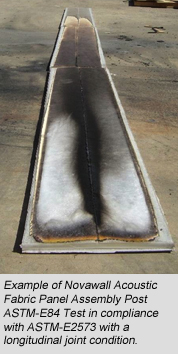 In commercial construction, fabric panels systems seldom hit the radar when Fire Code compliance is considered. They usually come to light after an incident. Typically, Plan Review Departments within some major metropolitan areas focus primarily on the obvious considerations of occupancy, egress, exits, stairwells, sprinkler heads and strobes long before wall finishes and then, sometimes they are not considered or reviewed at all. The continual non-enforcement of fire ratings and testing on textiles or fabric panel systems contributes to the complacency about fire code compliance for those systems. The lack of enforcement may actually make it appear to some contractors and designers that the code is non-existent, but the code does exist.
In commercial construction, fabric panels systems seldom hit the radar when Fire Code compliance is considered. They usually come to light after an incident. Typically, Plan Review Departments within some major metropolitan areas focus primarily on the obvious considerations of occupancy, egress, exits, stairwells, sprinkler heads and strobes long before wall finishes and then, sometimes they are not considered or reviewed at all. The continual non-enforcement of fire ratings and testing on textiles or fabric panel systems contributes to the complacency about fire code compliance for those systems. The lack of enforcement may actually make it appear to some contractors and designers that the code is non-existent, but the code does exist.
If a state, city or metropolitan area adopts the International Building Code (IBC), then wall finishes and fabric panel systems fall under Chapter 8 Section 803 for fire code compliance. Section 803.1.1 describes that “Interior wall and ceiling finish materials shall be classified in accordance with ASTM E84 or UL 723. Such Interior finish materials shall be grouped in the following classes in accordance with their flame spread and smoke developed indexes. Class A, B or C.”
What is true about the IBC is that it establishes the minimum requirements, and a jurisdiction cannot subtract from a code or contend that a section of the code does not apply. A jurisdiction can only add to the code, and usually those additions create more stringent requirements than the code may already provide. An example would be requiring that all wall finishes be Class A ASTM E84, regardless of location in a building or building type. These additions to the code are typically associated with local or regional events that may have had historically dire consequences for either the building occupants or those who protect us, such as first responders, police or fire personnel.
In 2007, the American Society for Testing Materials (ASTM) committee that governs products such as site-fabricated fabric panels and stretched fabric systems, adopted a historic change to ASTM E84, which is ASTM E2573-07. ASTM E2573 established a mandatory specimen preparation requirement using a longitudinal centered mid seam sample made up of the framing members of the system (wood grounds, plastic or aluminum) to provide more accurate flame spread and smoke developed indexes. This change to ASTM E84 does not discriminate across different systems or the materials that may be used to form these stretched fabric systems and its purpose is to provide testing samples and better understanding of a product’s flame and smoke performance when burning. This requirement also applies to wide span ceiling fabric systems. It was formally incorporated into the 2009 IBC under Section 803.13 Site-fabricated stretch systems.
In commercial construction, the professional liability for code compliance generally falls to both the company specifying the products and the company installing the products. Sometimes a manufacturer of a product or textile may have some level of deniability when professional liability is at issue. Either the product may not be marketed or intended for that particular end use or the manufacturer was unaware of how their product was actually being used, installed or specified. It is the specifier and installer who must verify that the product or textile specified meets or exceeds minimum fire code requirements or more specific local requirements for its intended end use. If you have specified a particular product and determined that the product’s fire testing is appropriate but a bidder is proposing to substitute an alternate product, it would be prudent to also evaluate the alternate product on its esthetic aspects and its fire testing as part of your approval process. Approving an alternate product is the same as selecting the original product; you are certifying that it meets minimum criteria for code compliance and assuming the liability that comes with the substitution.
In the absence of City enforcement, many products can be installed that do not meet minimum fire code requirement for a particular intended use. Think about the last time you had a project “red tagged” for an interior finish product that did not meet fire code. Never? When was the last time you confirmed that the finish selection actually met the required testing for its intended end use? Enforcement keeps us engaged and safe. Better enforcement of fire code weeds out products that just don’t meet code or have never been tested. It levels the market with manufacturers that have tested their products appropriately and have an interest in supporting commercial code compliance and in safety and the community as well.

